air condition TOYOTA PROACE 2020 Owners Manual (in English)
[x] Cancel search | Manufacturer: TOYOTA, Model Year: 2020, Model line: PROACE, Model: TOYOTA PROACE 2020Pages: 430, PDF Size: 48.01 MB
Page 2 of 430
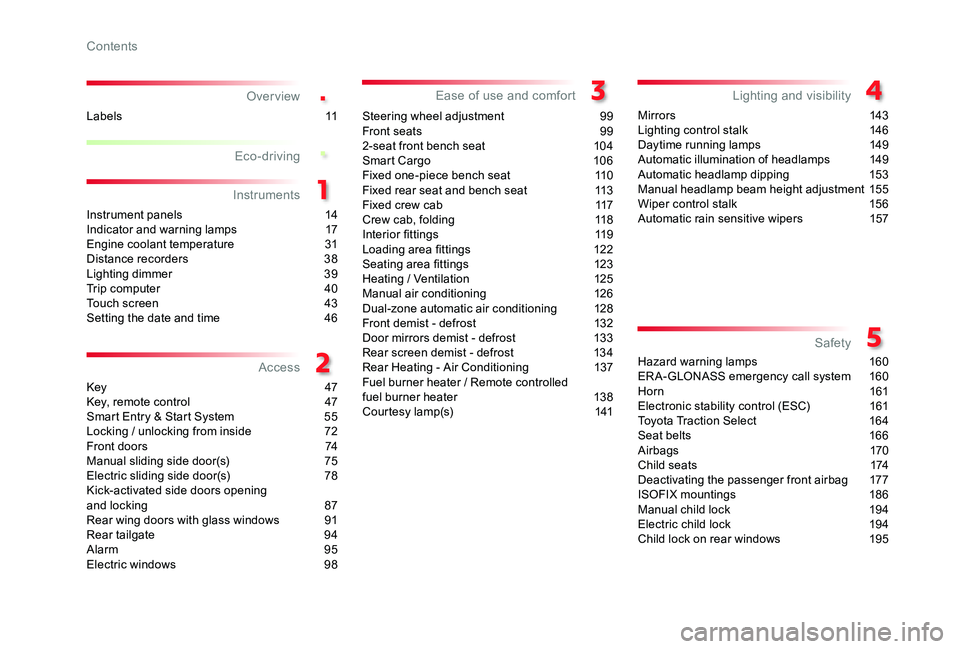
.
.
4
Over view
Instrument panels 14Indicator and warning lamps 17Engine coolant temperature 31Distance recorders 38Lighting dimmer 39Trip computer 40Touch screen 43Setting the date and time 46
Key 47Key, remote control 47Smart Entry & Start System 55Locking / unlocking from inside 72Front doors 74Manual sliding side door(s) 75Electric sliding side door(s) 78Kick-activated side doors openingand locking 87Rear wing doors with glass windows 91Rear tailgate 94Alarm 95Electric windows 98
Steering wheel adjustment 99Front seats 992-seat front bench seat 104Smart Cargo 10 6Fixed one-piece bench seat 110Fixed rear seat and bench seat 113Fixed crew cab 117Crew cab, folding 118Interior fittings 119Loading area fittings 122Seating area fittings 123Heating / Ventilation 125Manual air conditioning 126Dual-zone automatic air conditioning 128Front demist - defrost 132Door mirrors demist - defrost 133Rear screen demist - defrost 134Rear Heating - Air Conditioning 137Fuel burner heater / Remote controlledfuel burner heater 13 8Courtesy lamp(s) 141
Mir ror s 143Lighting control stalk 146Daytime running lamps 149Automatic illumination of headlamps 149Automatic headlamp dipping 153Manual headlamp beam height adjustment 155Wiper control stalk 156Automatic rain sensitive wipers 157
Hazard warning lamps 160ERA-GLONASS emergency call system 160Horn 161Electronic stability control (ESC) 161Toyota Traction Select 16 4Seat belts 166Airbags 170Child seats 174Deactivating the passenger front airbag 177ISOFIX mountings 186Manual child lock 194Electric child lock 194Child lock on rear windows 195
Eco-driving
Instruments
Access
Ease of use and comfortLighting and visibility
Safety
Labels 11
Contents
Page 6 of 430
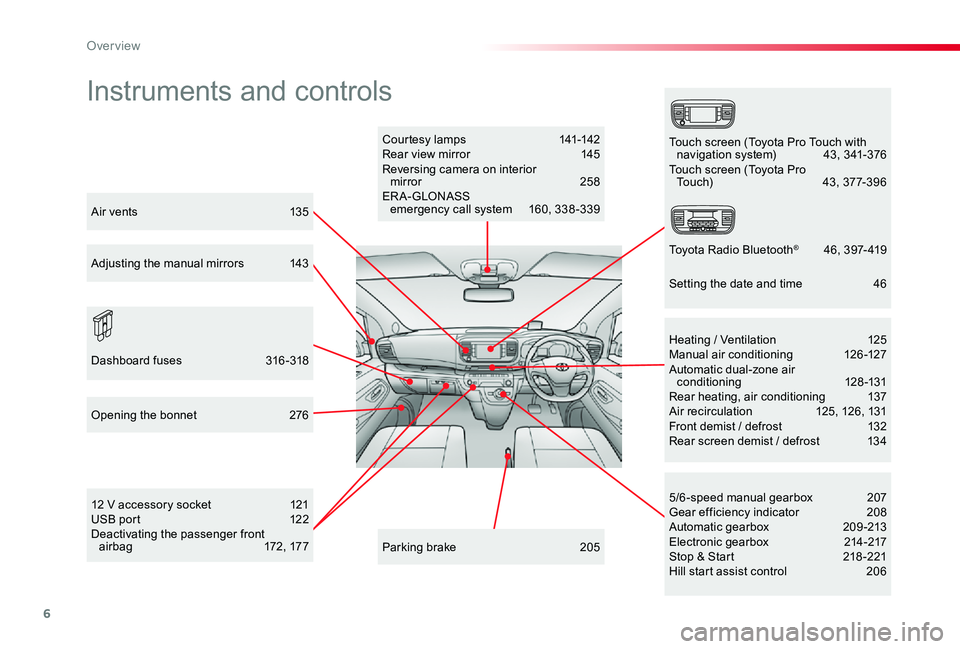
6
Instruments and controls
Courtesy lamps 141-142Rear view mirror 145Reversing camera on interior mirror 258ER A- GLONASS emergency call system 160, 338 -339
12 V accessory socket 121USB port 122Deactivating the passenger front a i r b a g 172 , 17 7
5/6-speed manual gearbox 207Gear efficiency indicator 208Automatic gearbox 209-213Electronic gearbox 214-217Stop & Start 218 -221Hill start assist control 206
Heating / Ventilation 125Manual air conditioning 126-127Automatic dual-zone air conditioning 128-131Rear heating, air conditioning 137Air recirculation 125, 126, 131Front demist / defrost 132Rear screen demist / defrost 134
Parking brake 205
Opening the bonnet 276
Dashboard fuses 316-318
Touch screen (Toyota Pro Touch with navigation system) 43, 341-376Touch screen (Toyota Pro Touch) 43, 377-396
Toyota Radio Bluetooth® 4 6 , 3 9 7- 419
Air vents 135
Adjusting the manual mirrors 143
Setting the date and time 46
Over view
Page 9 of 430
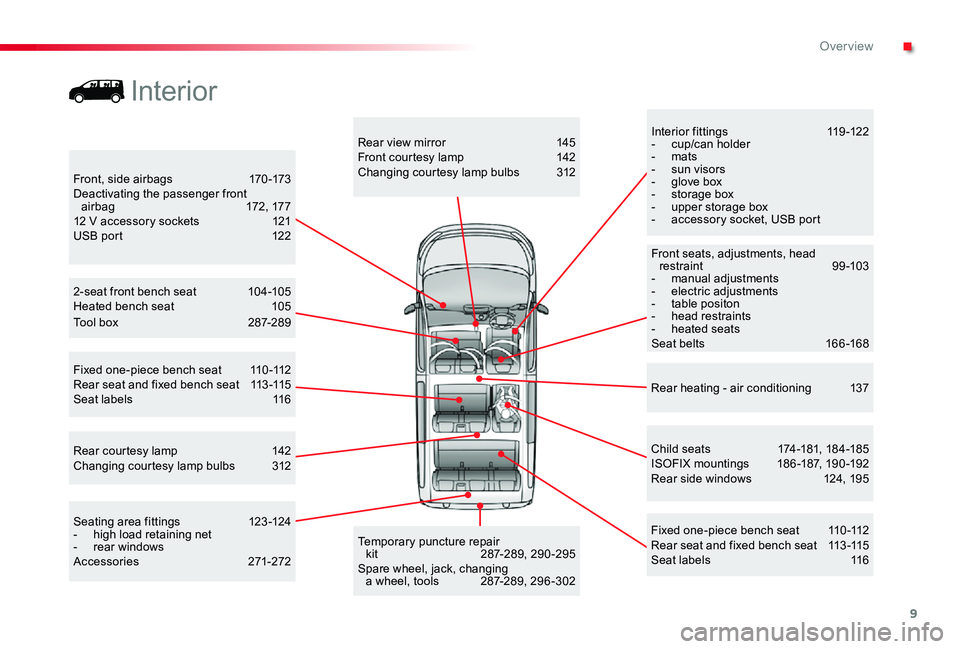
9
Interior fittings 119-122- cup/can holder- mats- sun visors- glove box- storage box- upper storage box- accessory socket, USB port
Child seats 174 -181, 18 4 -185ISOFIX mountings 186 -187, 190 -192Rear side windows 124, 195
Fixed one-piece bench seat 110-112Rear seat and fixed bench seat 113-115Seat labels 116
2-seat front bench seat 104-105Heated bench seat 105
Rear heating - air conditioning 137
Temporary puncture repair kit 287-289, 290 -295Spare wheel, jack, changing a wheel, tools 287-289, 296 -302
Seating area fittings 123-124- high load retaining net- rear windowsAccessories 271-272
Rear courtesy lamp 142Changing courtesy lamp bulbs 312
Rear view mirror 145Front courtesy lamp 142Changing courtesy lamp bulbs 312Front, side airbags 170 -173Deactivating the passenger front a i r b a g 172 , 17 712 V accessory sockets 121USB port 122
Front seats, adjustments, head restraint 99-103- manual adjustments- electric adjustments- table positon- head restraints- heated seatsSeat belts 166-168
Fixed one-piece bench seat 110-112Rear seat and fixed bench seat 113-115Seat labels 116
Interior
Tool box 287-289
.
Over view
Page 12 of 430
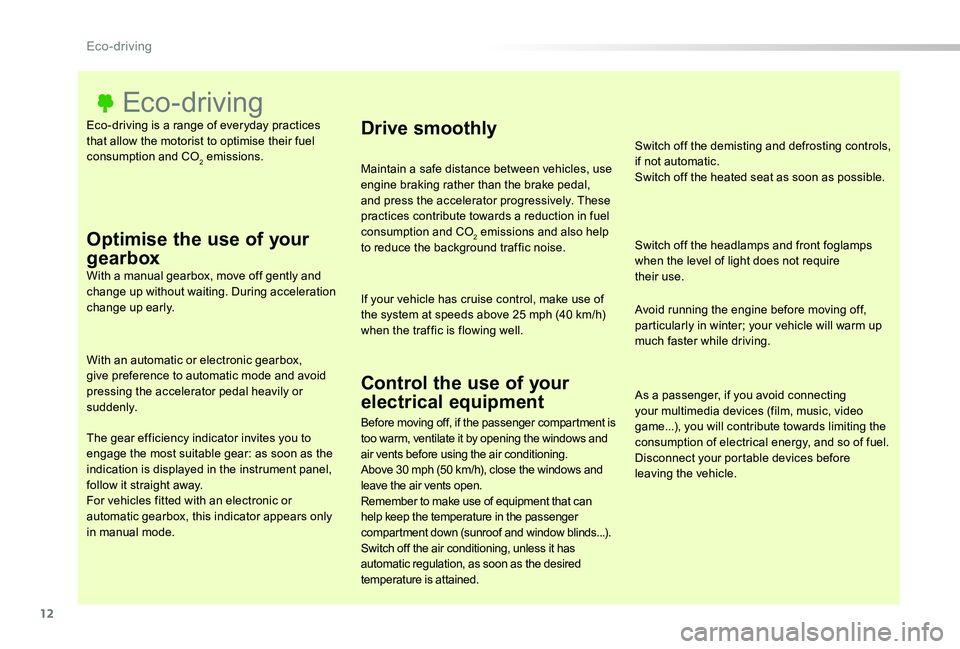
12
Eco-driving is a range of everyday practices that allow the motorist to optimise their fuel consumption and CO2 emissions.
Eco- driving
Optimise the use of your
gearboxWith a manual gearbox, move off gently and change up without waiting. During acceleration change up early.
With an automatic or electronic gearbox, give preference to automatic mode and avoid pressing the accelerator pedal heavily or suddenly.
The gear efficiency indicator invites you to
engage the most suitable gear: as soon as the indication is displayed in the instrument panel, follow it straight away.For vehicles fitted with an electronic or automatic gearbox, this indicator appears only in manual mode.
Drive smoothly
Maintain a safe distance between vehicles, use engine braking rather than the brake pedal, and press the accelerator progressively. These practices contribute towards a reduction in fuel consumption and CO2 emissions and also help to reduce the background traffic noise.
If your vehicle has cruise control, make use of the system at speeds above 25 mph (40 km/h) when the traffic is flowing well.
Control the use of your
electrical equipment
Switch off the demisting and defrosting controls, if not automatic.Switch off the heated seat as soon as possible.
Switch off the headlamps and front foglamps when the level of light does not require their use.
Avoid running the engine before moving off, particularly in winter; your vehicle will warm up much faster while driving.
As a passenger, if you avoid connecting your multimedia devices (film, music, video game...), you will contribute towards limiting the consumption of electrical energy, and so of fuel.Disconnect your portable devices before leaving the vehicle.
Before moving off, if the passenger compartment is too warm, ventilate it by opening the windows and air vents before using the air conditioning.Above 30 mph (50 km/h), close the windows and leave the air vents open.Remember to make use of equipment that can help keep the temperature in the passenger compartment down (sunroof and window blinds...).Switch off the air conditioning, unless it has automatic regulation, as soon as the desired temperature is attained.
Eco-driving
Page 21 of 430
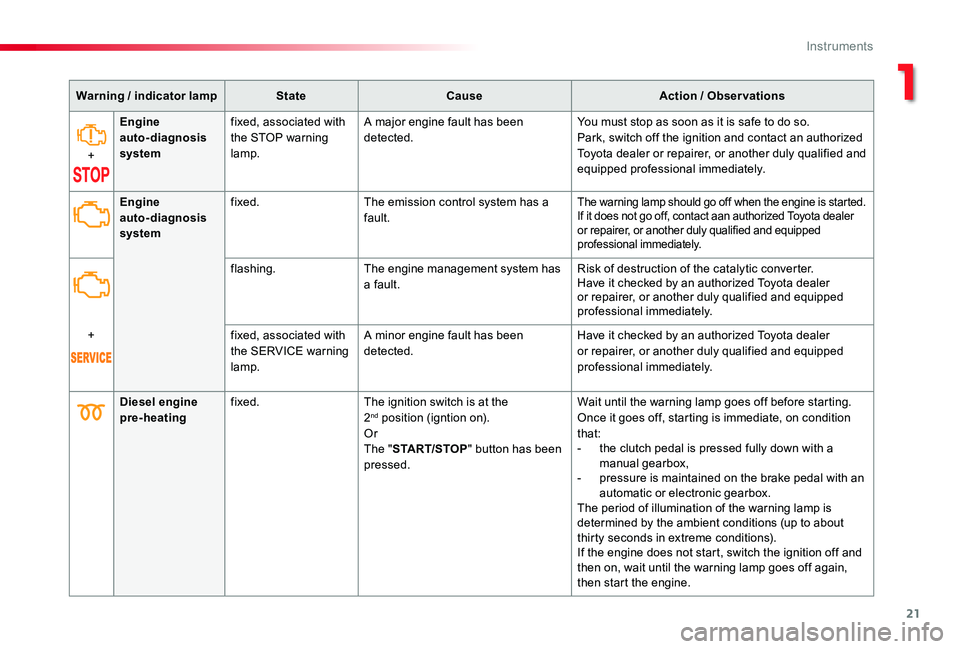
21
Warning / indicator lampStateCauseAction / Observations
+
Engine auto-diagnosis system
fixed, associated with the STOP warning lamp.
A major engine fault has been detected.You must stop as soon as it is safe to do so.Park, switch off the ignition and contact an authorized Toyota dealer or repairer, or another duly qualified and equipped professional immediately.
Diesel engine pre-heatingfixed.The ignition switch is at the 2nd position (igntion on).OrThe "START/STOP" button has been pressed.
Wait until the warning lamp goes off before starting.Once it goes off, starting is immediate, on condition that:- the clutch pedal is pressed fully down with a manual gearbox,- pressure is maintained on the brake pedal with an automatic or electronic gearbox.The period of illumination of the warning lamp is determined by the ambient conditions (up to about thirty seconds in extreme conditions).If the engine does not start, switch the ignition off and then on, wait until the warning lamp goes off again, then start the engine.
Engine auto-diagnosis system
fixed.The emission control system has a fault.The warning lamp should go off when the engine is started.If it does not go off, contact aan authorized Toyota dealer or repairer, or another duly qualified and equipped professional immediately.
flashing.The engine management system has a fault.Risk of destruction of the catalytic converter.Have it checked by an authorized Toyota dealer or repairer, or another duly qualified and equipped professional immediately.
+fixed, associated with the SERVICE warning lamp.
A minor engine fault has been detected.Have it checked by an authorized Toyota dealer or repairer, or another duly qualified and equipped professional immediately.
1
Instruments
Page 23 of 430
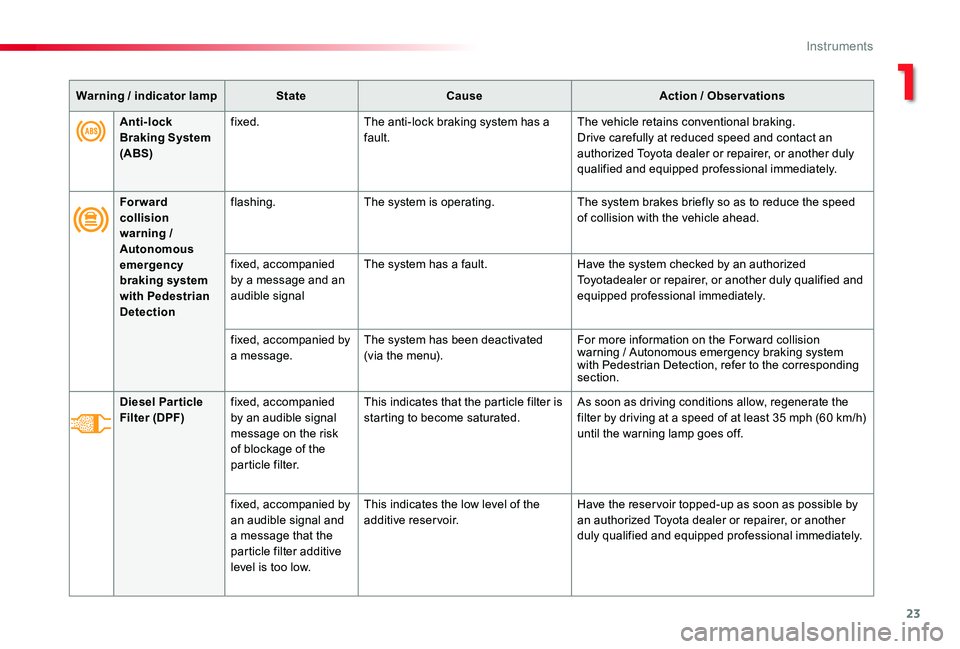
23
Anti-lock Braking System (ABS)
fixed.The anti-lock braking system has a fault.The vehicle retains conventional braking.Drive carefully at reduced speed and contact an authorized Toyota dealer or repairer, or another duly qualified and equipped professional immediately.
Warning / indicator lampStateCauseAction / Observations
For wardcollisionwarning /
Autonomousemergencybraking systemwith PedestrianDetection
flashing.The system is operating.The system brakes briefly so as to reduce the speed of collision with the vehicle ahead.
fixed, accompanied by a message and an audible signal
The system has a fault.Have the system checked by an authorized Toyotadealer or repairer, or another duly qualified and equipped professional immediately.
fixed, accompanied by a message.The system has been deactivated (via the menu).For more information on the Forward collision warning / Autonomous emergency braking system with Pedestrian Detection, refer to the corresponding section.
Diesel ParticleFilter (DPF)fixed, accompanied by an audible signal message on the risk of blockage of the particle filter.
This indicates that the particle filter is starting to become saturated.As soon as driving conditions allow, regenerate the filter by driving at a speed of at least 35 mph (60 km/h) until the warning lamp goes off.
fixed, accompanied by an audible signal and a message that the particle filter additive level is too low.
This indicates the low level of the additive reservoir.Have the reser voir topped-up as soon as possible by an authorized Toyota dealer or repairer, or another duly qualified and equipped professional immediately.
1
Instruments
Page 109 of 430
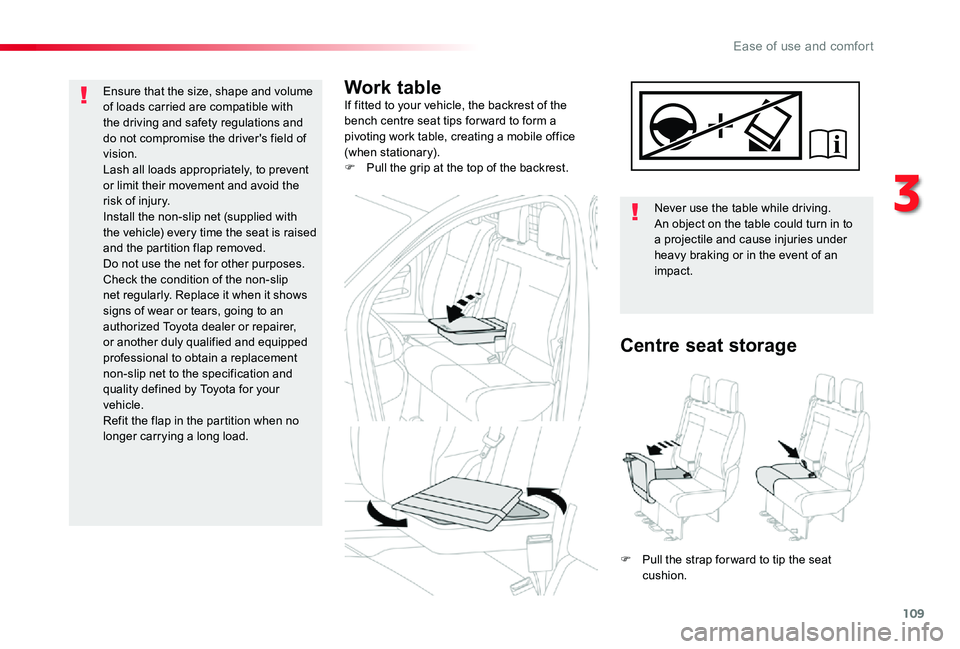
109
Work tableIf fitted to your vehicle, the backrest of the bench centre seat tips for ward to form a pivoting work table, creating a mobile office (when stationary).F Pull the grip at the top of the backrest.
Never use the table while driving.An object on the table could turn in to a projectile and cause injuries under heavy braking or in the event of an impact.
Centre seat storage
F Pull the strap for ward to tip the seat cushion.
Ensure that the size, shape and volume of loads carried are compatible with the driving and safety regulations and do not compromise the driver's field of vision.Lash all loads appropriately, to prevent or limit their movement and avoid the risk of injury.Install the non-slip net (supplied with the vehicle) every time the seat is raised and the partition flap removed.Do not use the net for other purposes.Check the condition of the non-slip net regularly. Replace it when it shows signs of wear or tears, going to an authorized Toyota dealer or repairer, or another duly qualified and equipped professional to obtain a replacement non-slip net to the specification and quality defined by Toyota for your vehicle.Refit the flap in the partition when no longer carrying a long load.
3
Ease of use and comfort
Page 120 of 430
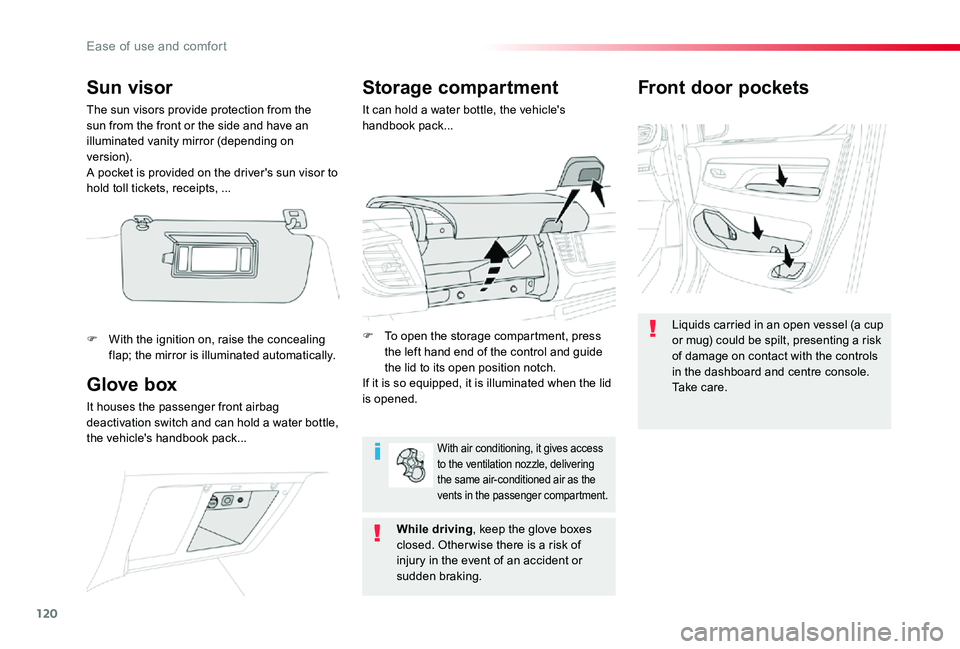
120
Front door pockets
Liquids carried in an open vessel (a cup or mug) could be spilt, presenting a risk of damage on contact with the controls in the dashboard and centre console. Ta k e c a r e .Glove box
It houses the passenger front airbag deactivation switch and can hold a water bottle, the vehicle's handbook pack...
Storage compartment
It can hold a water bottle, the vehicle's handbook pack...
F To open the storage compartment, press the left hand end of the control and guide the lid to its open position notch.If it is so equipped, it is illuminated when the lid is opened.
While driving, keep the glove boxes closed. Other wise there is a risk of injury in the event of an accident or sudden braking.
Sun visor
The sun visors provide protection from the sun from the front or the side and have an illuminated vanity mirror (depending on ve r s i o n).A pocket is provided on the driver's sun visor to hold toll tickets, receipts, ...
F With the ignition on, raise the concealing flap; the mirror is illuminated automatically.
With air conditioning, it gives access to the ventilation nozzle, delivering the same air-conditioned air as the vents in the passenger compartment.
Ease of use and comfort
Page 126 of 430
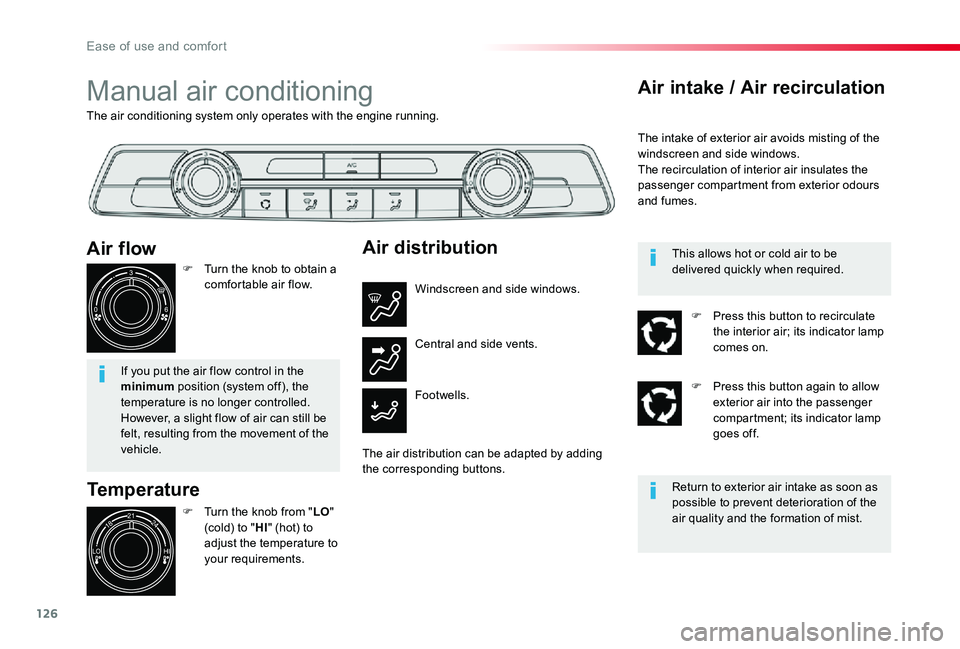
126
The air conditioning system only operates with the engine running.
Manual air conditioning
Temperature
F Turn the knob from "LO" (cold) to "HI" (hot) to adjust the temperature to your requirements.
Air flow
F Turn the knob to obtain a comfortable air flow.
If you put the air flow control in the minimum position (system off), the temperature is no longer controlled. However, a slight flow of air can still be felt, resulting from the movement of the vehicle.
Air distribution
Windscreen and side windows.
Footwells.
Central and side vents.
The air distribution can be adapted by adding the corresponding buttons.
Air intake / Air recirculation
The intake of exterior air avoids misting of the windscreen and side windows.The recirculation of interior air insulates the passenger compartment from exterior odours and fumes.
Return to exterior air intake as soon as possible to prevent deterioration of the air quality and the formation of mist.
This allows hot or cold air to be delivered quickly when required.
F Press this button to recirculate the interior air; its indicator lamp comes on.
F Press this button again to allow exterior air into the passenger compartment; its indicator lamp goes off.
Ease of use and comfort
Page 127 of 430
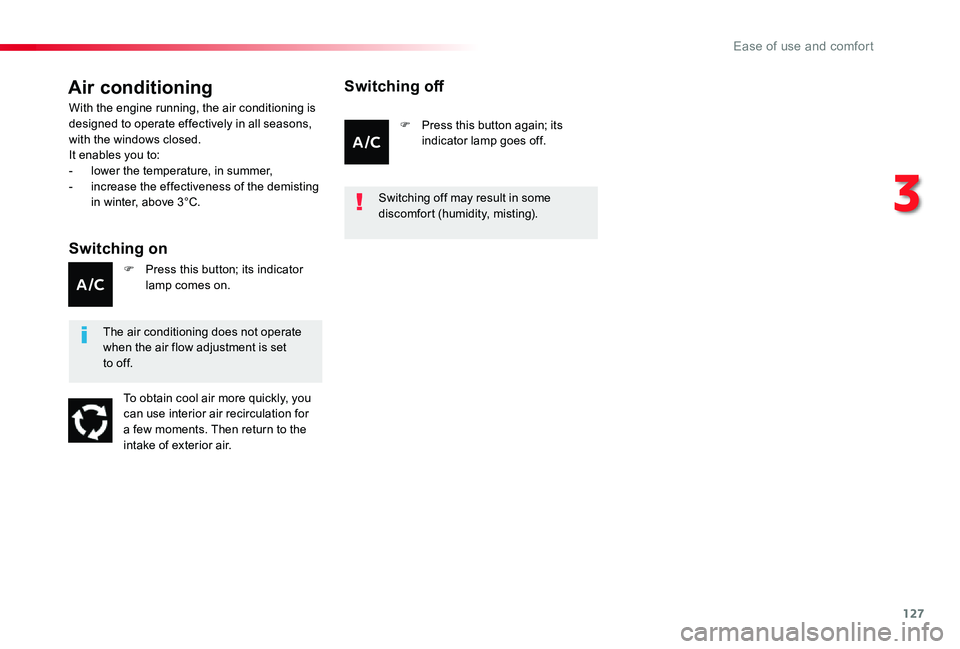
127
Air conditioning
Switching on
With the engine running, the air conditioning is designed to operate effectively in all seasons, with the windows closed.It enables you to:- lower the temperature, in summer,- increase the effectiveness of the demisting in winter, above 3°C.
To obtain cool air more quickly, you can use interior air recirculation for a few moments. Then return to the intake of exterior air.
F Press this button; its indicator lamp comes on.
F Press this button again; its indicator lamp goes off.
Switching off
The air conditioning does not operate when the air flow adjustment is set to off.
Switching off may result in some discomfort (humidity, misting).
3
Ease of use and comfort